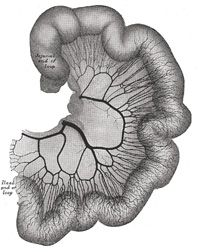The jejunum is an intraperitoneal organ, it is the second portion of the small intestine and part of the digestive tract. It begins at the duodenojejunal junction where it is related to the ligament of Treitz, and extends 8 to 9 feet, continuing distally with the ileum.
Being intraperitoneal, it is anchored to the posterior abdominal wall by the double-layered mesentery through which the jejunum receives its blood and nerve supply. At the root (base) of the mesentery are the superior mesenteric vessels.
The Latin word [jejunis] means "empty" or "fasting". The Latin term [jejunum] was used by the Romans to denote the first meal of the day, breakfast, when you have an "empty" stomach. The term was associated with this segment of the small intestine, as it is most of the time found empty in cadavers being dissected.
There is no clear anatomical boundary between the jejunum and ileum, as they blend smoothly one into the other. There are several gross changes from jejunum to ileum, one of them being that the complexity of the mesenteric arterial arches increases from proximal to distal. See the accompanying image. Click on it for a larger depiction.
Two interesting side notes: In English, the term for the first meal of the day is self-explanatory: [break - fast], adding to the Roman concept of "fasting" or "jejunum". In Spanish, the term for breakfast is [desayuno], where the word [ayuno] means "fasting", therefore the word [des-ayuno] also means "the end of fasting". Look at the evolution (in Spanish) from [jejunum] to [yeyuno] (the Spanish term for the organ) to [ayuno], meaning "fasting" or "empty".
Sources:
1. "The Origin of Medical Terms" Skinner, HA 1970 Hafner Publishing Co.
2. "Clinically Oriented Anatomy" Moore, KL. 3r Ed. Williams & Wilkins 1992
3 "Tratado de Anatomia Humana" Testut et Latarjet 8 Ed. 1931 Salvat Editores, Spain
4. "Anatomy of the Human Body" Henry Gray 1918. Philadelphia: Lea & Febiger Image modified by CAA, Inc. Original image by Henry Vandyke Carter, MD., courtesy of bartleby.com
